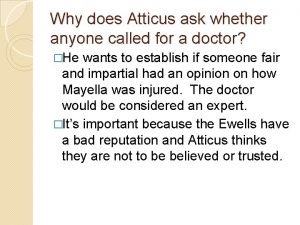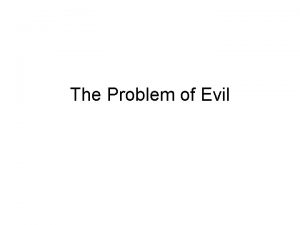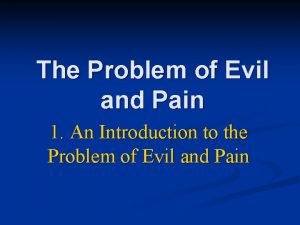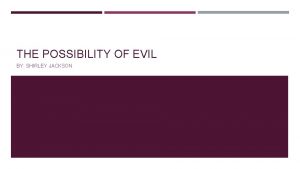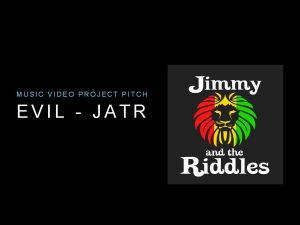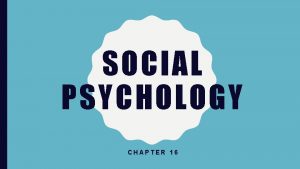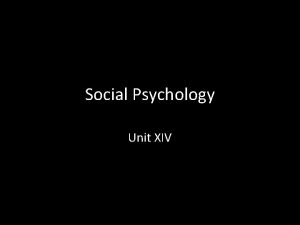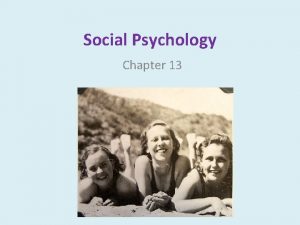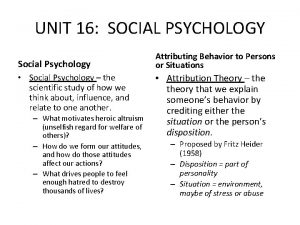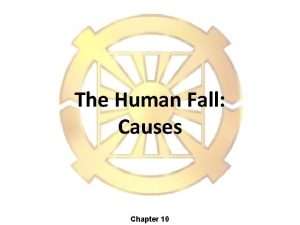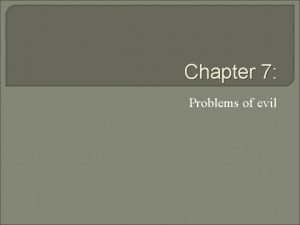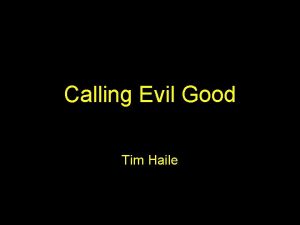SOCIAL PSYCHOLOGY Psychology of Evil COULD ANYONE OF









































- Slides: 41

SOCIAL PSYCHOLOGY Psychology of Evil

COULD ANYONE OF US COMMIT EVIL ACTS? v. Which factors might play a part why some people harm other people?

OBEDIENCE – WOULD YOU OBEY? v. Stanley Milgram’s experiments 1960/1962 v http: //www. youtube. com/watch? v=W 147 yb. Odgp. E

THE RESULTS v. The result: 2 / 3 of the 40 participants gave the highest electric shocks! v. The experiment showed that normally nice people with simple means can be made to execute other equally nice people.




MODERN TIME v A replication of his study-made in the present day: how do people react today? http: //www. youtube. com/watch? v=Bcv. SNg 0 HZwk

OTHER OBEDIENCE STUDIES v Hofling et al. 1966: obedience in American hospitals v Bickman 1974 v Gender? v Nationality? v Puppies?

TASK v. Read the study and summarize it into one paragraph (max. 200 words). Your summary should answer: What was the: - aim of the study? - Procedure? - Results?

GUESS HOW MANY BALLOONS






CONFORMITY – HOW ADJUSTABLE ARE YOU? v. Elevator: http: //www. youtube. com/watch? v=B 738 X-ibz 2 o

SOLOMON ASCH v. Solomon Asch’s experiment: http: //www. youtube. com/watch? v=i. Rh 5 qy 09 n. Nw&feature=rel ated http: //www. youtube. com/watch? v=TYIh 4 Mkcf. JA&feature=rela ted


CONFORMITY – HOW ADJUSTABLE ARE YOU? v Handout: Asch’s study. Summarize it as the Milgram study but with only 150 words!

BYSTANDER-EFFECT – WOULD YOU HELP? v. Kitty Genovese: Http: //www. youtube. com/watch? v=Jozm. WS 6 x. YEw&feature=related v Girl being kidnapped in the USA http: //www. youtube. com/watch? v=KIv. GIw. Lc. Iuw And another…Smoke filled room: http: //www. youtube. com/watch? v=KE 5 Yw. N 4 NW 5 o

HAVE YOU EVER BEEN IN THE NEED OF HELP? OR SEEN OTHERS BEEN? DID THEY HELP YOU/ YOU HELP THEM? v. Why do you think nobody helped? v. What does it take for somebody to help?

BYSTANDER EFFECT • The tendency to be less likely to help if others are also present v Smoke-filled room study (Latané and Darley, 1968) • IV: left alone • with 2 other real participants • with 2 other confederates who pretended nothing was wrong • DV: Percentage of participants who reported smoke

SMOKE-FILLED ROOM STUDY 80 Percent who report smoke 60 40 2 0 0 Alone With 2 other real subjects With 2 calm confederates

MORE VIDEOS v http: //www. youtube. com/watch? v=B 5 A 5 Dq 25 UB 0 v http: //www. youtube. com/watch? v=8 FCb. Nr 4 r 2 j. Q&featur e=related

SITUATIONAL INFLUENCES: 5 STEPS TO HELPING v Step 1: Notice the Event • In order to help, you must realize something is happening • Often people are distracted and don’t even notice (especially in large cities) v Step 2: Interpret as Emergency • If you see someone lying on the sidewalk, does that mean they need or want help? • Pluralistic ignorance can play a role here • Others not helping, must not be a problem

5 STEPS TO HELPING v Step 3: Feel responsible • Just because you notice someone in need of help, is that your problem? • Diffusion of responsibility plays a role at this step v Step 4: Know how to help • If someone appears to need medical care and you’re not a nurse or doctor, then what? • If you can’t offer appropriate help, you will likely not try

5 STEPS TO HELPING v Step 5: Assess costs of helping • You see someone in need of help, you feel responsible, you know what to do, but… • Could be highly dangerous • Could make you financially liable • Could embarrass you


THE MORE BYSTANDERS…

MORE STUDIES v Piliavin et al. – subway in NY (proximity of bystanders and situation may play a role) (next slides) v Darley and Latane - the number of bystanders ( discussion over an intercom v 2 in the group: 85% helped v 3 in the group: 62% v 5 other subejcts: 31 %


THE SITUATIONAL DETERMINANTS OF HELPING BEHAVIOUR v The reaction of others: people look to each other to know how to act v The number of bystanders: a diffusion of responsibility occurs when many witnesses are present. More witnesses can actually men less helping! v The closeness of bystanders: the closer the more likely to help (face to face vs. over the phone) on the street vs. subway v Ambiguity, environmental location and the norms of the society

v Results/Findings v Helping behaviour was very high and much higher than earlier laboratory studies. v The cane victim received spontaneous help on 62 out of the 65 trials, and the drunk victim received spontaneous help on 19 out of 38 trials.

v On 60% of the 81 trials where spontaneous help was given, more than one person offered help. Once one person had started to help, there were no differences for different victim conditions (black/white, cane/drunk) on the number of extra helpers that appeared. v The race of the victims made no significant difference to helping behaviour, but there was a slight tendency for same-race helping in the drunken condition.

v It was found that 90% of helpers were male. Although there were more men present, this percentage was statistically significant. v Diffusion of responsibility was not evident. The diffusion of responsibility hypothesis predicts that helping behaviour would decrease as the number of bystanders increases. In fact the field experiment found that the quickest help came from the largest groups.

FOR YOU! v. Since you were so brilliant at acting last time… v. In groups of 3 -4, produce and perform a roleplay of either obedience, conformity or bystander -effect. v. You get 15 minutes to rehearse, then it’s show time!

PRISON STUDY By Zimbardo, Haney and Banks (1973) v. They wanted to demonstrate the situational rather than the dispositional causes of negative behaviour. v. Read the study and answer the following questions: Why did they simulate a prison for their experiment? What factors contributed to the study’s result?

CONCLUSION Philip Zimbardo shows how people become monsters. . . or heroes "Philip Zimbardo knows how easy it is for nice people to turn bad. In this talk, he shares insights and graphic unseen photos from the Abu Ghraib trials. Then he talks about the flip side: how easy it is to be a hero, and how we can rise to the challenge. " Ted Talks vhttp: //www. ted. com/talks/philip_zimb ardo_on_the_psychology_of_evil. html


ASSESSMENT SOCIAL PSYCHOLOGY: PSYCHOLOGY OF EVIL Essay: Criteria B, C & D 2 -3 pages, 1, 5 space, size 12, bibliography 1. Pick one historical/current event/crime and summarize the event/outcome. 2. Then analyse that event/outcome/crime to reasons that we have studied for why and how people turn to negative behaviour, to see if one could come to another conclusion today or give an alternative answer to the “why”.
 Repay no one evil for evil
Repay no one evil for evil Indifference to evil is evil
Indifference to evil is evil Groupthink vs group polarization
Groupthink vs group polarization Fundamental attribution error ap psychology
Fundamental attribution error ap psychology Social psychology is the scientific study of:
Social psychology is the scientific study of: Social thinking and social influence in psychology
Social thinking and social influence in psychology Social thinking and social influence in psychology
Social thinking and social influence in psychology Social thinking social influence social relations
Social thinking social influence social relations Elements of spoken word poetry
Elements of spoken word poetry Anyone lived in a pretty how town literary devices
Anyone lived in a pretty how town literary devices Preach another jesus
Preach another jesus You owe nothing to anyone
You owe nothing to anyone Don't let anyone take your crown
Don't let anyone take your crown You owe nothing to anyone
You owe nothing to anyone The boeing 747 is twice bigger than the boeing 707
The boeing 747 is twice bigger than the boeing 707 Something anything someone anyone somewhere anywhere
Something anything someone anyone somewhere anywhere Why does jocasta's story upset oedipus
Why does jocasta's story upset oedipus A dependent adult is anyone over the age of 65.
A dependent adult is anyone over the age of 65. Who is absent today
Who is absent today Of course anyone who has ever perused
Of course anyone who has ever perused If anyone desires to come after me
If anyone desires to come after me Not just anyone
Not just anyone If anyone says he loves god but
If anyone says he loves god but Therefore if anyone is in christ
Therefore if anyone is in christ If anyone thinks he is religious
If anyone thinks he is religious Cursed is the man who hangs on a tree
Cursed is the man who hangs on a tree Beware lest anyone cheat you
Beware lest anyone cheat you Don't let anyone look down on you because you are young
Don't let anyone look down on you because you are young Where anyone can be anything
Where anyone can be anything Lettuce anyone
Lettuce anyone Three main aims of the sia
Three main aims of the sia Nearly anyone
Nearly anyone I am sick of you add a question tag
I am sick of you add a question tag Do not let anyone look down on you
Do not let anyone look down on you Why does atticus ask about the doctor
Why does atticus ask about the doctor 607 jerusalem
607 jerusalem Degree of comparison of evil
Degree of comparison of evil The epicurean paradox
The epicurean paradox Evil acts examples
Evil acts examples Problem of evil
Problem of evil The possibility of evil characters
The possibility of evil characters Evil-merodach
Evil-merodach


































